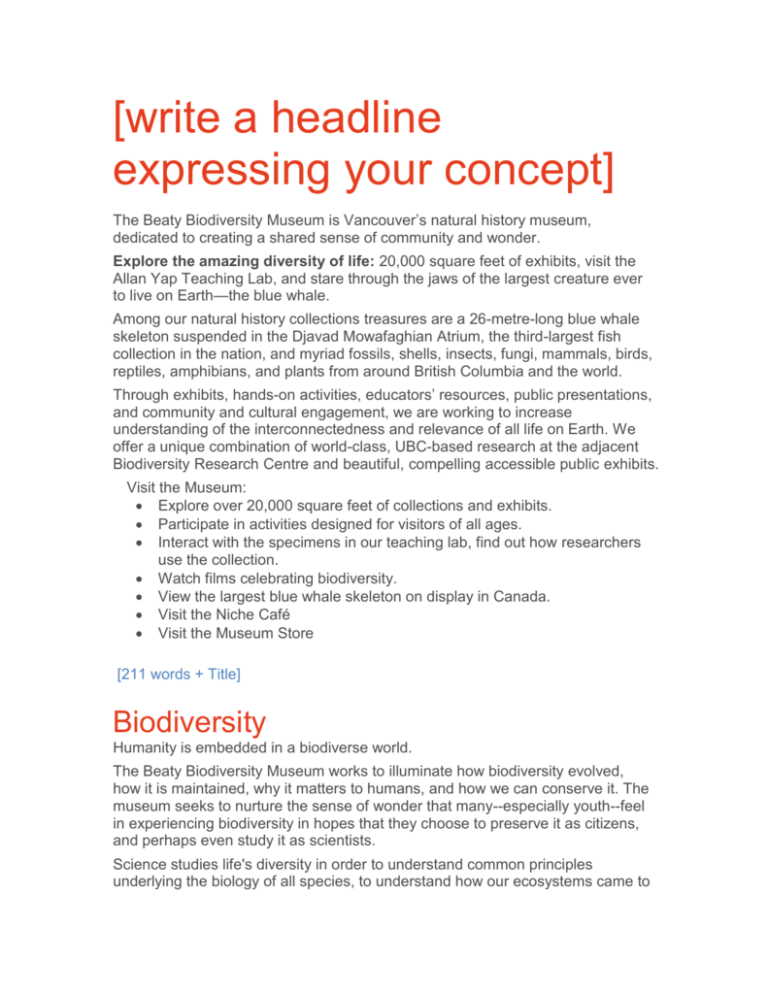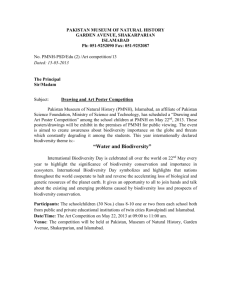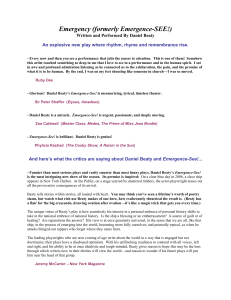Project 2 Text
advertisement

[write a headline expressing your concept] The Beaty Biodiversity Museum is Vancouver’s natural history museum, dedicated to creating a shared sense of community and wonder. Explore the amazing diversity of life: 20,000 square feet of exhibits, visit the Allan Yap Teaching Lab, and stare through the jaws of the largest creature ever to live on Earth—the blue whale. Among our natural history collections treasures are a 26-metre-long blue whale skeleton suspended in the Djavad Mowafaghian Atrium, the third-largest fish collection in the nation, and myriad fossils, shells, insects, fungi, mammals, birds, reptiles, amphibians, and plants from around British Columbia and the world. Through exhibits, hands-on activities, educators’ resources, public presentations, and community and cultural engagement, we are working to increase understanding of the interconnectedness and relevance of all life on Earth. We offer a unique combination of world-class, UBC-based research at the adjacent Biodiversity Research Centre and beautiful, compelling accessible public exhibits. Visit the Museum: Explore over 20,000 square feet of collections and exhibits. Participate in activities designed for visitors of all ages. Interact with the specimens in our teaching lab, find out how researchers use the collection. Watch films celebrating biodiversity. View the largest blue whale skeleton on display in Canada. Visit the Niche Café Visit the Museum Store [211 words + Title] Biodiversity Humanity is embedded in a biodiverse world. The Beaty Biodiversity Museum works to illuminate how biodiversity evolved, how it is maintained, why it matters to humans, and how we can conserve it. The museum seeks to nurture the sense of wonder that many--especially youth--feel in experiencing biodiversity in hopes that they choose to preserve it as citizens, and perhaps even study it as scientists. Science studies life's diversity in order to understand common principles underlying the biology of all species, to understand how our ecosystems came to be and how they function, and to learn how to act sustainably. Since the early 20th century, biologists at UBC have archived specimens of the many species they have studied in our natural history collections. These specimens, over two million to date, hold precious information about species and ecosystems of the past and present, and are guarded as time capsules sent to biologists centuries into the future. During these past decades our effort has grown, making UBC one of the world's leading universities in biodiversity research. But those decades have also seen biodiversity, and humanity's future, ever more imperilled. The museum's world-class researchers, curators, and dedicated and creative outreach staff all work toward celebrating human responses to biodiversity, including art, culture, and our own love for biodiversity. At its core, the museum is designed to spread enthusiasm by revealing the amazing stories and beauty of biodiversity. [235 words] Your value-added concept information Head and subhead, other text as required This is to be placed where it is appropriate in your project layout. History of the Museum The Collections The biological collections that are the centrepiece of the Beaty Biodiversity Museum were each started by a different collector, some as early as the 1910s. Over the decades, the collections were added to by myriad researchers, and grew to contain over 2 million specimens. In 2001, researchers at the Biodiversity Research Centre and within the departments of Botany and Zoology envisioned a building that would facilitate interdisciplinary work on biodiversity, house UBC's biodiversity researchers and collections, and contain a public natural history museum. For years, Ross Beaty envisioned a museum of natural history in British Columbia, a community asset that would profile the amazing wonders of the natural world, in one of the most species-rich places on earth. Ross and Trisha Beaty, UBC alumni, demonstrated inspirational vision and foresight through an exceptional leadership gift which enabled UBC create a museum in which the collections are available for the public to view. [157 words] Cowan Tetrapod Collection The Cowan Tetrapod Collection’s over 40,000 specimens of mammals, birds, amphibians, and reptiles represent every continent on Earth, with most coming from western Canada. The Herbarium Herbaria provide a permanent record of our changing flora over time, documenting all plant species discovered so far, their variation, and their past and present distributions. They hold a treasure trove of anatomical, chemical, ethnobotanical, and molecular information, and document the history of plant exploration. The Herbarium is the largest collection of dried plant and fungi specimens in western Canada, with more than 660,000 specimens. The world’s largest collection of BC plants and Canada’s largest collection of bryophytes are housed in the Herbarium. Spencer Entomological Collection The Spencer Entomological Collection is the second largest collection in Western Canada, holding over 600,000 specimens that highlight the diversity of British Columbia's insects and other arthropods, as well as jumping spiders from around the world. The Fish Museum The Fish Collection boasts over 800,000 specimens, with particularly spectacular and important holdings from Canada, the Aleutians, the Malay Archipelago, Mexico, the Galapagos, Panama, and the Amazon. Marine Invertebrate Collection The Marine Invertebrate Collection contains thousands of specimens representing the major lineages of animals, such as cnidarians, molluscs, annelids, crustaceans, echinoderms, and sponges. Fossil Collection The Fossil Collection contains over 20,000 specimens that range from recent shells to 500-million-year old fossils of blue-green algae, as well as specimens from British Columbia’s famous Burgess Shale. [239 words] Research The Beaty Biodiversity Museum is part of UBC’s Beaty Biodiversity Centre, bringing the University’s world-class biodiversity researchers and natural history collections together into an innovative building complex. The Biodiversity Research Centre (BRC) is composed of more than 50 internationally renowned scientists, all dedicated to the study of biodiversity. Interdisciplinary working groups study the biological forces that produce and sustain biodiversity, as well as the forces that lead to extinction and the local and global consequences of its loss. Scientists at the BRC investigate the ecology, evolution, conservation and maintenance of biological diversity through research at all levels, from genes to ecosystems through to interactions with society. As the scope of global climate change, human-caused habitat alterations, and associated extinction rates rise, the need to understand and conserve biodiversity and the ecosystem functions that it sustains has never been more pressing. [141 words] The Blue Whale Exhibit The Beaty Biodiversity Museum is home to Canada's largest blue whale skeleton, a magnificent exhibit that illustrates the interconnectedness of all living things. Blue whales are the largest animal ever to have lived on earth. They rarely strand on beaches, and very few skeletons have been recovered for research or display. Worldwide, only 21 are available to the public for viewing. On the remote northwestern coast of PEI in 1987, a 26 m long mature female blue whale died and washed ashore near the town of Tignish. In hopes of preserving the whale's skeleton for research or museum display, the PEI government and the Canadian Museum of Nature arranged for the skeleton to be dragged off the beach near Nail Pond, and buried. The remains of the whale were longer than two Vancouver trolley buses parked one behind the other, and weighed an estimated 80,000 kg. Her burial was a mammoth task. Because of the difficulty of unearthing and displaying such a large animal, the whale skeleton remained under the red PEI dirt for two decades. The process of retrieving, degreasing, repairing and articulating it began in 2007 and the installation in the Beaty Biodiversity Museum was completed in May 2010. 205 words Visiting the Museum Current hours and events: www.beatymuseum.ubc.ca/ Individual Admission: Adult: $12 Senior, non-UBC student (with ID) and youth (13–17): $10 Child (5–12 years) Must be accompanied by an adult: $8 Family: $35 UBC Alumni (with Alumni Card): 2 for 1 Child (under 5 years, accompanied by an adult): Free UBC faculty, staff, or student (with ID): Free GROUPS: 10 OR MORE, SELF-GUIDED, PRICES INCLUDE TAXES Group Admission: Adult: $10 Senior, non-UBC student (with ID) and youth (13–17 years): $9 Child (5–12 years): $7 Museums and Gardens Pass Includes: Museum of Anthropology (MOA), UBC Botanical Garden, Nitobe Garden, and Beaty Biodiversity Museum Adult: $33 Youth/Student/Senior 65+: $28 Youth/Student/Senior 65+; Family (2 adults and up to 4 children under 18): $85 Also receive 20% savings on UBC Bookstore books, clothing, and gifts, 15% savings on food items purchased at Café MOA and the Beaty Museum's Niche Cafe, AND 10% savings on admission to the Greenheart Forest Canopy Walkway! Passports are valid for 6 months, and may be purchased NOW at the Beaty Museum, MOA, Nitobe Garden, and UBC Botanical Garden-- your passport to adventure at UBC. Get yours today! Beaty Biodiversity Museum University of British Columbia 2212 Main Mall Vancouver, BC, Canada V6T 1Z4 F: 604.827.5350 E: info@beatymuseum.ubc.ca P: 604.827.4955 INDIVIDUAL ADMISSION: PRICES INCLUDE TAXES





